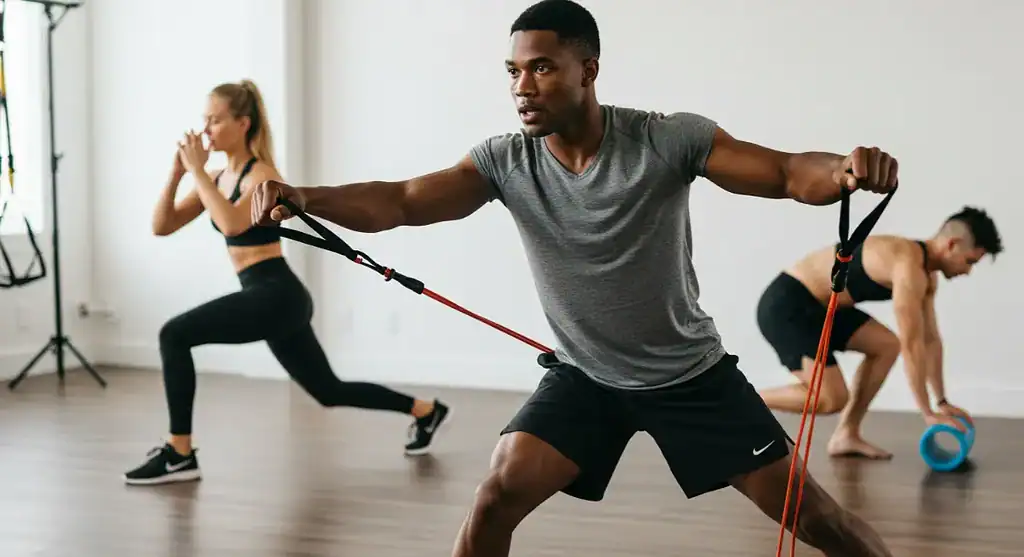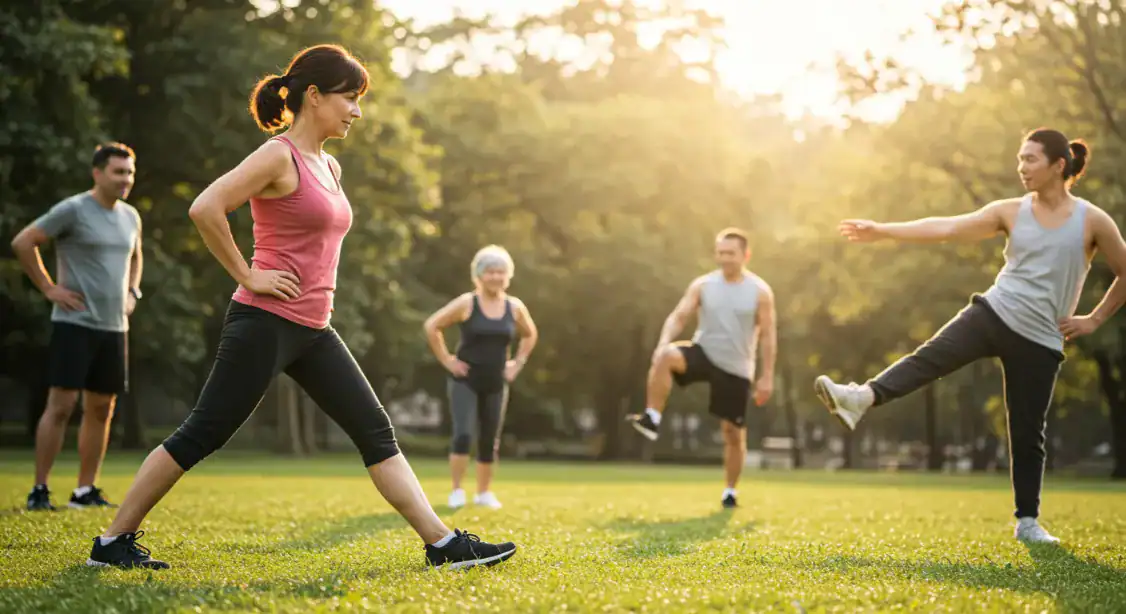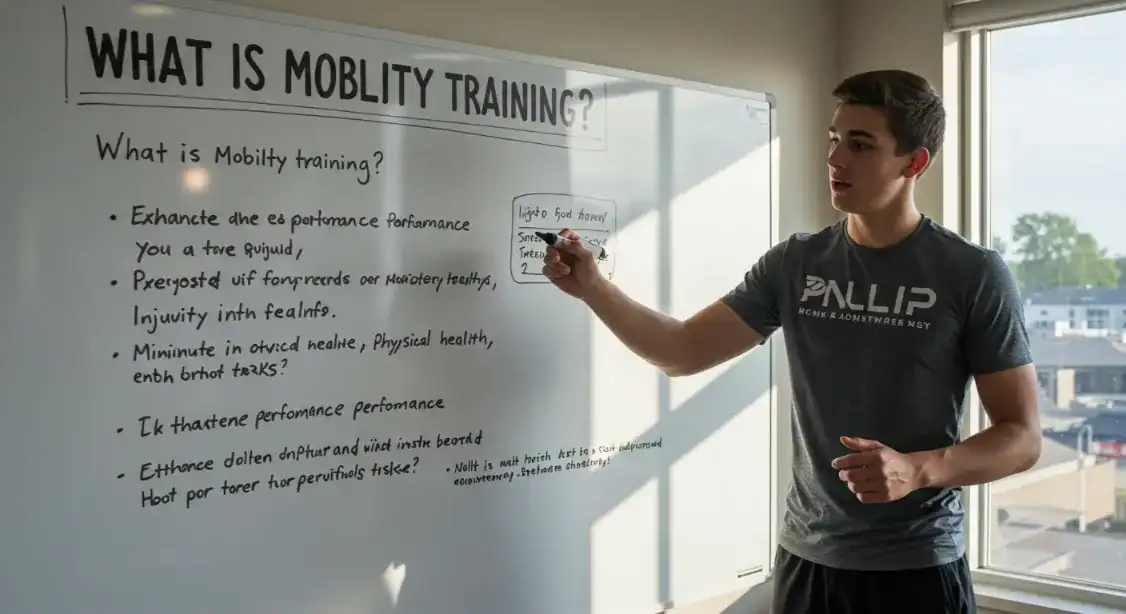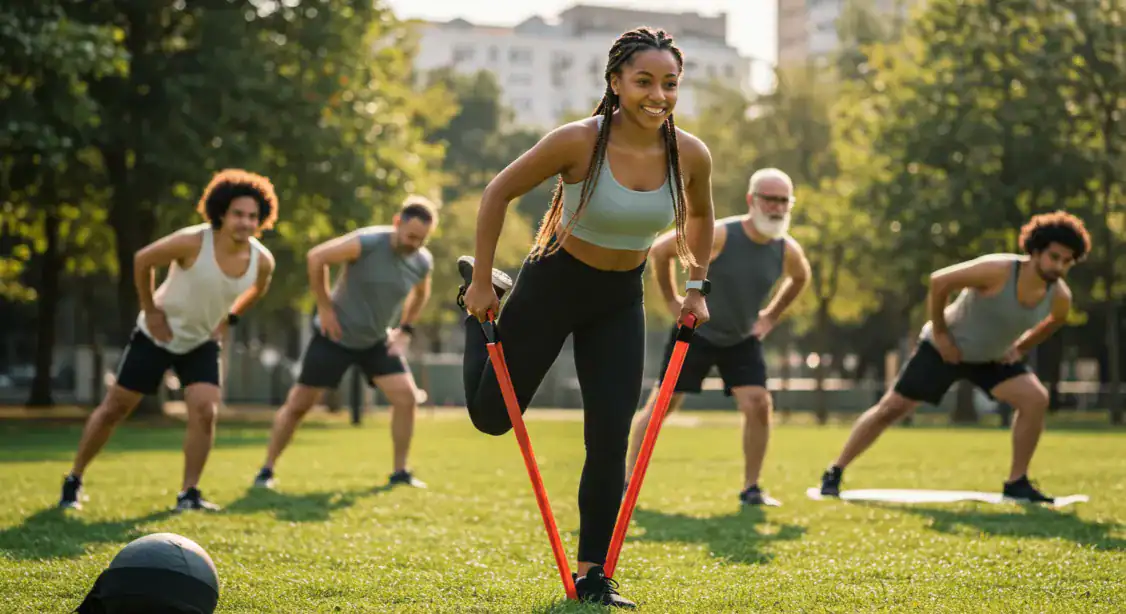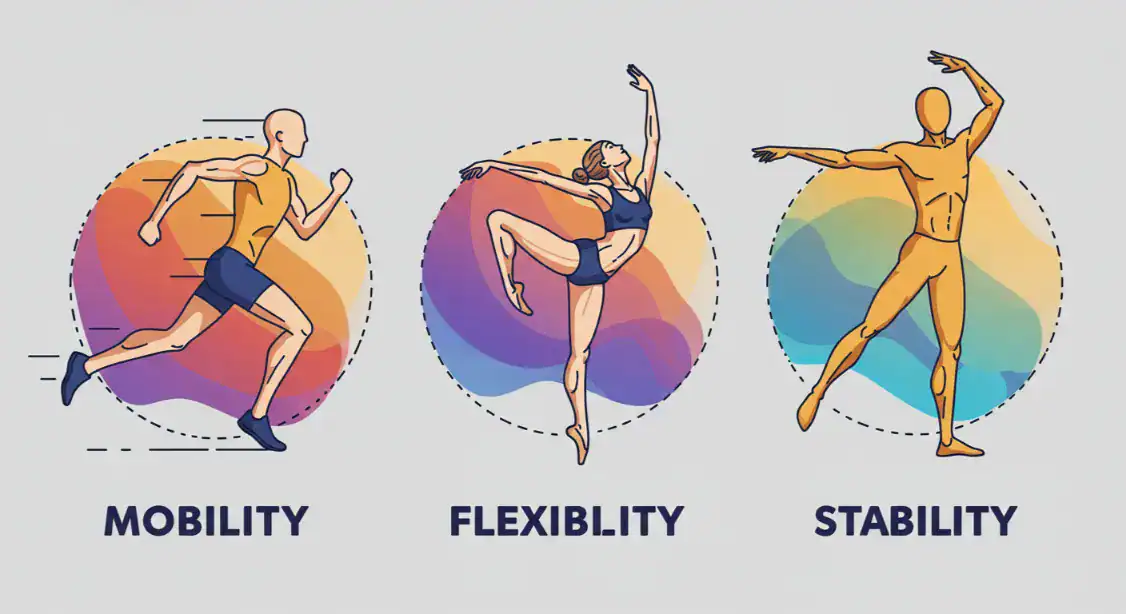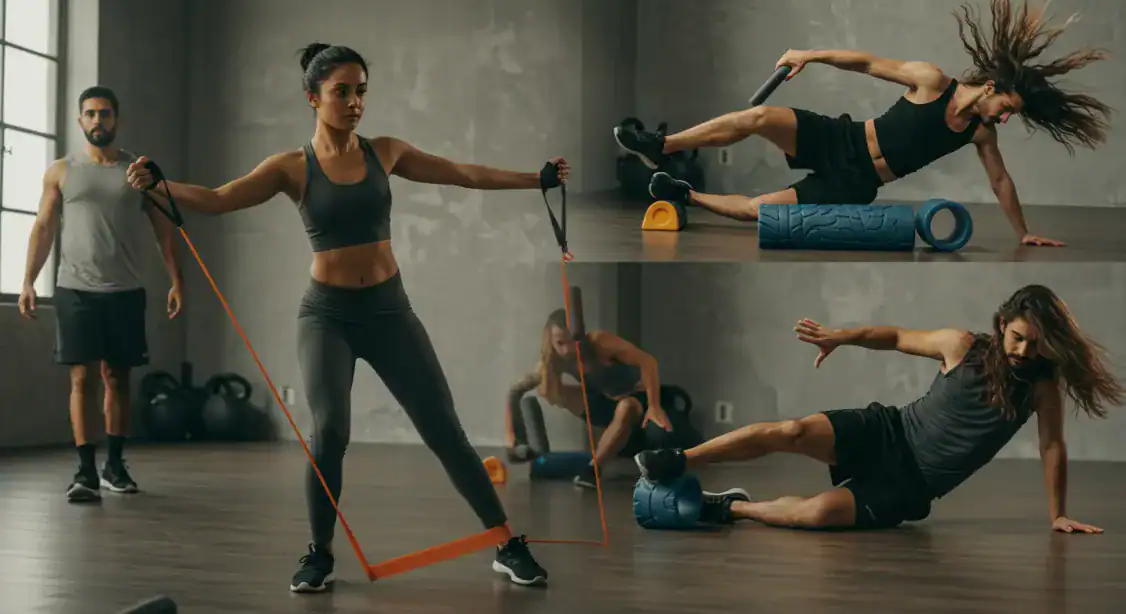How do you improve your mobility? You train your joints to move through their full range of motion with active control and strength. This is mobility training. It’s the difference between being passively flexible and actively strong in your movements. This guide shows you how to build it.
🔑 Key Takeaways
- Active Control: Mobility is your joint’s ability to actively move through its maximum range with strength, not just passive stretching.
- 4 Major Benefits: It reduces injury risk by up to 28%, boosts athletic performance, improves daily movement, and alleviates chronic pain.
- 5 Foundational Drills: Start with Cat-Cow, Thoracic Rotations, Hip CARs, Ankle CARs, and the World’s Greatest Stretch.
- 10-Minute Rule: Consistent, short sessions (10-20 mins, 5+ days/week) are more effective than occasional long ones.
- Listen to Your Body: Mobility work should feel like a productive challenge, not sharp joint pain. Stop if you feel pain.
Forget just stretching. Mobility training teaches your body to own its movement potential. It upgrades your body’s operating system for smoother, more efficient functional movements.
Whether your goal is a deeper squat, injury-free running, or simply getting off the floor with ease, focusing on mobility is non-negotiable. That pinch in your shoulder or tightness in your hips is a signal. Ignoring it is inefficient and increases your risk of injury. Good mobility is fundamental to a higher quality of life.
Unpacking Mobility: More Than Just Being Bendy
Let’s clear up the confusion between flexibility and mobility. Flexibility is passive. Think about using a strap to pull your leg towards your head. Your hamstring is stretching, but you are not actively controlling that range.
Mobility is active. It’s lifting your knee to your chest using your hip flexor strength. Or performing a deep squat with control through your hips, knees, and ankles. That’s joint mobility in action—it requires muscle strength, coordination, and nervous system engagement. You need active control.
Why does this matter? Life requires active movement. Picking up groceries, throwing a ball, walking—these are functional movements demanding optimal mobility. Improving it refines your movement patterns, making you stronger and more efficient. This foundational work complements specialized training like CrossFit for teens.
My Personal Experience: I used to blame tight hamstrings for my poor squat depth. Stretching didn’t help. Then I focused on hip mobility drills like controlled leg swings and Hip CARs (Controlled Articular Rotations). It was about teaching my hip joint to move freely and actively. Within weeks, I achieved a deeper squat with better form and my lower back pain faded. It highlighted the power of active range of motion. For more on squats, check out the benefits of adding barbell squats to your set.
The Real-World Wins: Why Prioritize Mobility Training?
This isn’t a trend. The effects of mobility training deliver tangible, evidence-based benefits.
Injury Prevention Powerhouse
This is the biggest benefit. Better joint mobility lets your body absorb and distribute force effectively. When joints move freely, there’s less stress on connective tissues and fewer compensatory movements that lead to strain. Dynamic stretching increases blood flow and warms tissues, preparing the body for load. A 2026 analysis in the Journal of Sports Science & Medicine notes that integrated mobility work can reduce non-contact injury risk by up to 28%. For targeted advice, see how to avoid injuries while working out.
Unleash Your Performance Potential
Want to run faster or lift heavier? Optimal mobility is your foundation. It allows better positions to generate force—a deeper squat, a more efficient golf swing. A 2026 systematic review in Sports Medicine confirms mobility training maintains or improves performance metrics like power and agility. Improved movement patterns mean less wasted energy. Considering high-intensity work? See how many calories HIIT burns.
Upgrade Your Daily Life
Mobility dramatically impacts your quality of life. Reaching overhead, gardening, or playing with kids becomes easier. Good joint movement reduces stiffness from sitting. This is vital for community-dwelling older adults, where maintaining mobility is key to independence. Research in the Journal of Aging and Physical Activity supports mobility interventions. For tailored exercises, explore chair exercises for older adults with limited mobility.
Better Posture and Less Pain
Stuck at a desk? Mobility exercises for the thoracic spine, shoulders, and hips counteract slumping. This leads to significant posture improvement and reduces chronic aches linked to poor alignment. Techniques popularized by physical therapists like Kelly Starrett and the GOWOD app focus on these corrective patterns.
Your Mobility Toolkit: Simple Exercises to Start Today
You need a little space and consistency. Focus on smooth, controlled movements. No momentum.
Foundational Mobility Exercises
Integrate these into warm-ups or as “movement snacks.” Aim for 8-10 reps or 30-60 seconds per side.
- Cat-Cow:
- Start: Hands and knees.
- Move: Inhale, arch back (Cow). Exhale, round spine (Cat). Move vertebra by vertebra. Great for spinal mobility.
- Thoracic Spine Rotations (Open Books):
- Start: Lie on side, knees bent, arms extended.
- Move: Keep hips stacked. Rotate top arm open, then return. Improves upper back rotation crucial for posture.
- Hip CARs (Controlled Articular Rotations):
- Start: Stand tall or on hands and knees.
- Move: Draw the biggest possible circle with your knee, moving the hip through its full range. Control is key. Reverse. Targets hip mobility.
- Ankle CARs:
- Start: Sit or stand. Lift one foot.
- Move: Draw big circles with your toes, isolating the ankle joint. Clockwise and counter-clockwise.
- World’s Greatest Stretch:
- Start: High plank.
- Move: Step foot outside hand. Drop elbow toward instep. Rotate chest open, reach arm up. Return and repeat on other side. Hits hips, thoracic spine, and hamstrings.
Tools That Can Help (But Aren’t Required)
- Resistance Bands: Add challenge to leg swings or shoulder work. Find the best resistance bands here.
- Foam Rollers & Lacrosse Balls: Address soft tissue restrictions. Use before mobility drills. Explore foam roller options.
- Yoga Blocks: Provide support to make positions accessible, letting you focus on the joint.
- Stick Mobility: Uses specialized sticks to improve range, stability, and body awareness.
Making Mobility Stick: Integrating it Seamlessly
Here’s how to make mobility part of your lifestyle.
When and How Often?
- Daily Dose: Aim for 10-20 minutes most days (5+). Consistency beats duration.
- Warm-up Wonder: Use 5-10 minutes of dynamic movements before workouts. This is superior to static stretching for performance.
- Cool-down Companion: Gentle mobility post-workout aids recovery. Learn more about how to recover from workouts.
- Movement Snack: Do 2 minutes of neck rolls or spinal twists every hour at your desk. It adds up.
Progressing Your Practice
- Increase Range: Gradually move through a larger range of motion, maintaining control.
- Add Complexity: Move from joint circles to multi-joint patterns.
- Introduce Holds: Pause for 2-3 seconds at end ranges to build strength.
- Use Tools: Incorporate resistance bands or Stick Mobility for challenge.
- Consider Guidance: A physical therapist or a reputable app like GOWOD or Pliability can provide personalized guidance.
Common Pitfalls to Avoid
- Pain vs. Discomfort: Stretching discomfort is okay. Sharp joint pain is not. Stop.
- Rushing: Sloppy, fast movements defeat the purpose. Be slow and controlled.
- Ignoring Weakness: Mobility requires strength at end ranges. Don’t neglect control.
- Inconsistency: Sporadic work won’t yield results. Make it a habit.
The Bottom Line: Invest in Your Movement Freedom
Mobility training is a fundamental investment. It makes your body resilient and capable for the long haul. The beneficial effects are well-documented, from reducing injury risk to improving quality of life for all ages.
Dedicate a small amount of time consistently. Focus on active control through your range of motion. Start simple. Be patient. Your body will thank you today and for years to come. Ready for the next step? Explore how to make fitness a part of your lifestyle.
❓ Frequently Asked Questions
What’s the difference between mobility and flexibility?
Flexibility is passive range (how far a muscle can be stretched). Mobility is active range (how far you can move a joint using your own muscle strength and control). You need both, but mobility is what you use in daily life and sport.
How often should I do mobility training?
Aim for short sessions (10-20 minutes) at least 5 days a week. Daily is ideal. Consistency with brief practice is far more effective than one long session per week.
Can mobility training help with back pain?
Yes. Often, back pain stems from stiffness in adjacent areas like the hips or thoracic spine. Targeted mobility work for these regions, like hip CARs and thoracic rotations, can significantly reduce discomfort by improving overall movement patterns.
Is it better to do mobility before or after a workout?
Do dynamic mobility (like leg swings, cat-cow) as a warm-up to prepare your joints. Use gentle, controlled mobility or static stretching as part of your cool-down to aid recovery and reduce muscle soreness.
What if I feel pain during a mobility exercise?
Stop immediately. A stretching sensation or mild discomfort is normal. Sharp, pinching, or joint pain is a signal to regress the movement, reduce range, or consult a physical therapist to assess the issue.
References
- Mobility training in sporting populations: A systematic review – Sports Medicine
- Mobility training for improving mobility in older adults – Cochrane Database
- Mobility vs. Flexibility: What’s the Difference? – ISSA Online
- Mobility Interventions for Older Adults – Journal of Aging and Physical Activity
- Benefits of Daily Mobility Exercises – ACE Fitness
- Kelly Starrett’s Mobility & Movement Resources – The Ready State
- Personalized Mobility Programming – GOWOD App
Alexios Papaioannou
Mission: To strip away marketing hype through engineering-grade stress testing. Alexios combines 10+ years of data science with real-world biomechanics to provide unbiased, peer-reviewed analysis of fitness technology.
